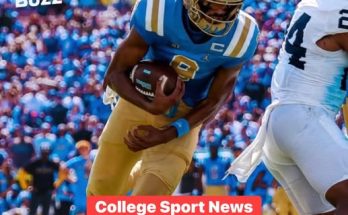The Texas Longhorns’ spring football scrimmage provided a tantalizing glimpse into the team’s potential for the upcoming season, and it left fans buzzing with optimism about what lies ahead in Austin. For the Longhorns, the event was not just a routine practice but a showcase of emerging talent, strategic depth, and the tangible growth of a program eager to reassert itself in the competitive landscape of college football. Among the highlights of the scrimmage, three major storylines stood out: Arch Manning’s poised performance under center, Ryan Wingo’s consistent excellence in the receiving corps, and a defensive line that imposed its will on every facet of the scrimmage. Each of these elements offers a reason for Longhorn fans to feel confident heading into the season, as the combination of elite skill, leadership, and defensive dominance has the potential to make Texas a formidable force in the conference and beyond.
Arch Manning, the highly touted quarterback recruit whose name carries national recognition and lofty expectations, delivered a performance that validated his reputation and underscored the promise he brings to the Longhorns’ offense. From the outset of the scrimmage, Manning exhibited a remarkable command of the offense, demonstrating the poise, accuracy, and decision-making that has made him one of the most exciting prospects in college football. Observers noted that Manning’s mechanics appeared refined, his throws precise, and his ability to read defensive alignments notably advanced for a player at his level of collegiate experience. Time and again, he connected with receivers on intermediate and deep routes, threading the needle through tight windows while maintaining an aura of calm under pressure. What impressed coaches and fans alike was not just his physical talent but his mental acuity—the way Manning processed the defense in real time, adjusted his footwork, and made quick, confident decisions. In a scrimmage setting, where experimentation is common and mistakes are tolerated, Manning’s performance stood out for its consistency and maturity, signaling that he is not only capable of handling the spotlight but thrives in it. His comfort in the pocket, combined with his ability to extend plays with both his arm and his legs, makes him a dual-threat option that defenses will need to account for throughout the season.
While Manning’s performance was undoubtedly a centerpiece of the scrimmage, Ryan Wingo emerged as a reliable and dynamic weapon in the Longhorns’ receiving corps. Wingo, known for his route-running precision and dependable hands, demonstrated why he is poised to be a go-to target for Manning. Throughout the scrimmage, Wingo displayed an uncanny ability to find soft spots in the defense, creating separation and making contested catches look routine. His awareness on the field, combined with his ability to adjust mid-route, allowed him to consistently convert difficult throws into completions. Coaches repeatedly praised Wingo for his work ethic and consistency, noting that he approaches every snap with the same intensity as a game situation. In addition to his receiving skills, Wingo’s contributions in blocking and situational awareness further underscored his value as a complete player, capable of impacting the game in multiple dimensions. For the Longhorns, having a reliable receiver like Wingo allows the offense to operate with a level of versatility and confidence that can be a difference-maker in close games. His chemistry with Manning was evident throughout the scrimmage, with timing, anticipation, and trust forming the foundation of several impressive drives. As defenses attempt to game-plan for Manning’s arm and mobility, Wingo’s ability to execute precise routes and secure tough catches will be essential to keeping the offense balanced and unpredictable.
On the defensive side of the ball, the Longhorns’ line demonstrated a level of physicality and discipline that left an indelible mark on the scrimmage. The D-line dominated both the run and pass games, with players exhibiting a rare combination of strength, technique, and football IQ. Time and again, the defensive front penetrated the offensive line, disrupted timing, and forced hurried decisions, highlighting the depth and talent of a unit that could be a cornerstone of Texas’ defensive identity. Coaches emphasized the importance of this group not only for creating sacks and tackles for loss but for setting the tone and instilling confidence in the linebackers and secondary. The D-line’s ability to control the line of scrimmage created opportunities for stunts, blitzes, and coverage schemes that put additional pressure on the opposing offense. Moreover, their performance in the scrimmage reflected the team’s emphasis on fundamentals, gap discipline, and relentless pursuit—qualities that often separate good defenses from great ones. With a line capable of consistently disrupting the backfield, Texas’ defense gains a strategic advantage that allows for more aggressive play-calling and situational flexibility, making it difficult for opponents to establish rhythm or exploit weaknesses. The dominance of the D-line also complements the offensive storylines, as strong defensive performance in practice and scrimmages fosters a culture of accountability and competition across the roster.
Beyond individual performances, the scrimmage showcased the Longhorns’ offensive schemes and their adaptability. Manning’s execution was complemented by a variety of formations, tempo adjustments, and situational plays that allowed the coaching staff to assess both strategy and personnel in real time. The offensive line showed marked improvement in pass protection, run blocking, and communication, creating an environment where Manning and his receivers could operate efficiently. The integration of tight ends, backs, and wide receivers into complex route combinations indicated a thoughtful approach to offensive versatility, suggesting that Texas is preparing to exploit mismatches and keep defenses off balance. Equally important was the team’s ability to operate in high-pressure, fast-paced situations without succumbing to mistakes, reflecting a mental toughness and preparation that bodes well for the competitive grind of the season.
On the other hand, the defense’s scrimmage performance highlighted more than just the D-line’s dominance. Linebackers and defensive backs were tested in coverage, tackling, and reaction to RPOs and play-action, revealing a unit willing to challenge itself against one of the most talented quarterbacks in college football. The level of communication and alignment discipline throughout the defensive squad suggested that the Longhorns are building a cohesive system capable of adjusting on the fly, which is critical for countering diverse offensive schemes they will face in conference play. Defensive backs, in particular, had to adapt to Manning’s ability to stretch the field and create windows for receivers like Wingo. Their ability to respond, adjust, and sometimes anticipate Manning’s reads reflected both preparation and raw athleticism.
Team dynamics also emerged as a crucial theme during the scrimmage. Arch Manning’s leadership on the field was complemented by veteran players who demonstrated mentorship and guidance, creating a culture where younger athletes can thrive while contributing meaningfully. Ryan Wingo’s performance, in particular, highlighted how skill players can elevate their teammates, inspire confidence, and enforce standards of excellence. Meanwhile, the defensive line’s cohesion and synchronized effort underscored the value of teamwork, communication, and trust among players in high-pressure scenarios. These intangible elements, while not always captured in statistics, play a significant role in shaping a team capable of competing at a high level. The Longhorns’ scrimmage indicated that beyond raw talent, there is a foundation of leadership, accountability, and chemistry that could prove decisive in close contests.
Another important takeaway from the scrimmage was the versatility of the roster. Texas demonstrated depth at several positions, with players stepping up in rotation and showcasing skills that could be pivotal as the season unfolds. The coaching staff’s willingness to experiment with different personnel groups and situational packages allowed them to evaluate talent comprehensively while keeping players engaged and motivated. This depth is especially critical in a physically demanding season where injuries and fatigue can test a team’s resilience. The ability to maintain performance levels with multiple personnel options ensures that Texas will not be overly reliant on a single player or unit, enhancing their competitiveness over the course of the season.
The scrimmage also offered a glimpse into the potential ceiling of the team if all the moving parts continue to develop in harmony. Arch Manning’s maturation as a quarterback, Ryan Wingo’s reliability as a receiver, and the D-line’s dominance collectively suggest that Texas could operate as a balanced, high-performing team capable of challenging for conference supremacy. This balance is crucial in modern college football, where a combination of offensive efficiency, defensive pressure, and special teams execution often determines outcomes in high-stakes games. Coaches and analysts alike took note of the Longhorns’ ability to execute at a high level in multiple areas simultaneously, which may provide a strategic edge over opponents who rely more heavily on one-dimensional approaches.
Looking ahead, the performance in the scrimmage sets high expectations for the upcoming season. For Manning, continued development in reading defenses, accuracy under pressure, and chemistry with receivers like Wingo will be essential. For the defensive line, sustaining dominance while adjusting to in-game variables and opponent strategies will be a constant challenge. And for the team as a whole, maintaining a culture of preparation, focus, and adaptability will be critical in navigating a demanding schedule. Fans have reason to be excited, but the scrimmage also serves as a reminder that execution, consistency, and resilience will ultimately determine how the season unfolds.



